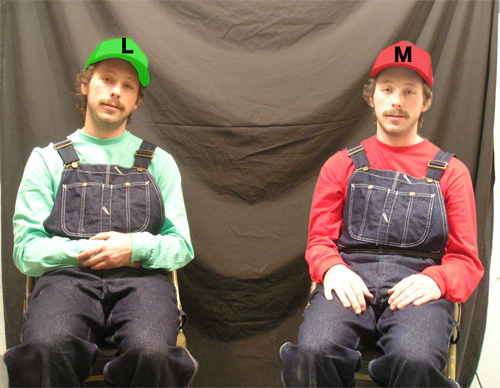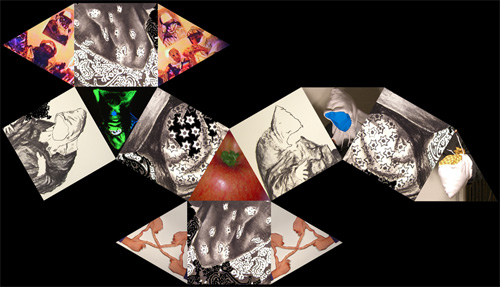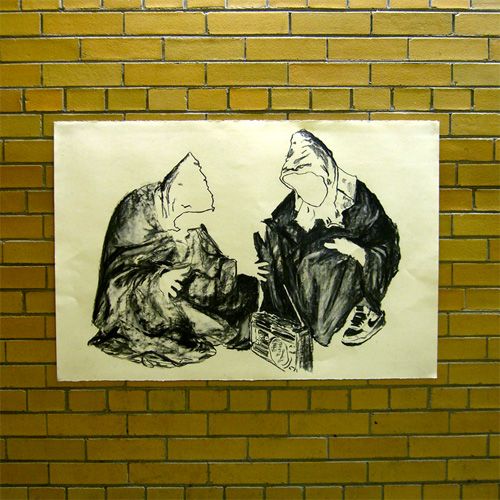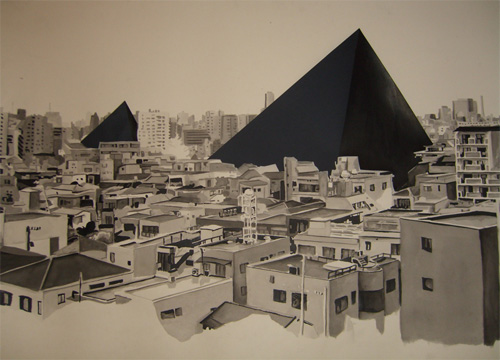[This year at the Northwestern MFA thesis exhibition openings at the Block Museum, each of the four students had their work presented by an Art Theory and Practice faculty member. Jeanne Dunning spoke about Cole Pierce, Micheal Rakowitz about Julie Rudder, Kelly Kaczinski about Stephen Nyktas and me, Steve Reinke, on Ryan Fenchel. The following is based on my presentation, which actually took the form of a dialogue with a hand puppet: Fenchel constructed a crude likeness of Mario from Super Mario Brothers for me to use. However, it wasn't much of a dialogue, so I reproduce it here as a monologue.]
Ryan Fenchel
Hi. My name is Steve Reinke and I'm up here to talk about the work of Ryan Fenchel. I have some assistance in the form of a hand puppet Ryan made for me. It's Mario, one of the Mario Brothers from the video game, Super Mario Brothers. I've become attached to Mario over the last few days, but I have to admit that this puppet Mario is just a stand-in -- a kind of cheap substitute -- for the one I'm really sweet on: Luigi. Ryan structured his thesis paper as a conversation between himself and some of his recurring characters. Here's a list of the dramatis personae: Secret societies, nature, geometry, madlib, quasomoto, mf doom, alchemy, the legend of Zelda nes game, carl sagan, weed, mario, luigi, my multi-religious upbringing, judaism, and john anthony west. Despite the inclusion of such characters as nature, geometry and alchemy, his work is at no point allegory. Likewise, I would say there is no metaphor in Fenchel's work. Metonymy is the dominant figure. Things don't stand in for other things, abstract concepts are not allegorized as concrete things or characters. Instead, there are potentially endless chains of associations, things are substituted for other things more or less like them. Things rub against one another, are arranged -- sometimes in regulated geometric patterns, sometimes like stars in a constellation -- and there is always something contingent in these arrangements: components could be switched or substituted without the autonomy of the Fenchel world being compromised. It doesn't fall apart. If the work were allegory, if the components were metaphors, a particular arrangement would be necessary. Two other things to say about Fenchel's work. Last year, Ryan created his own secret society in the woods behind his parent's house. He played all the parts: leader, member, acolyte, initiate. And he photographed himself performing all the parts in these rituals and then retrospectively combined the separate photographs into single images in which he appears multiple times. Initially these images appear to be photographic documentation of subcultural or secret society rituals, but as we realize the figures are always Ryan, they move from documentary to that particular type of documentary: the self-portrait. There is another way in which I find it really productive to think about the work in relation to the self-portrait. In the Masonic and alchemical material that he uses, in the combinations he makes -- combinations that seem to need a key to be decoded, or if not a key, then at least some system of arcane knowledge -- there is a kind of paranoiac structure, though Fenchel inverts it. The classic paranoid structure in which an individual faces the external world and finds it structured and encoded in a way that pertains directly to him, yet the ability to decode it is just out his grasp. Fenchel inverts this by first internalizing the external world -- the world of codes, clues, rituals -- though he keeps the paranoiac structure of it intact, just for fun. By turning this world into a self-portrait, it becomes a kind of paranoiac playground: ominous, at times, but generally unthreatening and endlessly generative.
|



